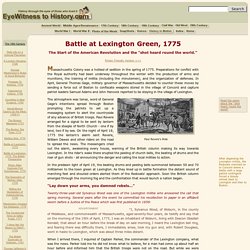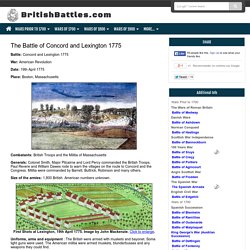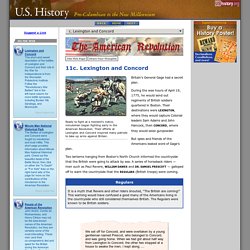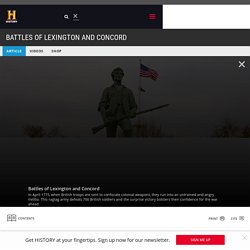Zoom
Trash

Minute Man National Historical Park. Battle at Lexington Green, 1775. Battle at Lexington Green, 1775 Massachusetts Colony was a hotbed of sedition in the spring of 1775.

Preparations for conflict with the Royal authority had been underway throughout the winter with the production of arms and munitions, the training of militia (including the minutemen), and the organization of defenses. In April, General Thomas Gage, military governor of Massachusetts decided to counter these moves by sending a force out of Boston to confiscate weapons stored in the village of Concord and capture patriot leaders Samuel Adams and John Hancock reported to be staying in the village of Lexington. The atmosphere was tense, word of General Gage's intentions spread through Boston prompting the patriots to set up a messaging system to alert the countryside of any advance of British troops. Paul Revere arranged for a signal to be sent by lantern from the steeple of North Church - one if by land, two if by sea. References: Commager, Henry Steele, Morris Richard B.
The Battle of Concord Lexington. Battle: Concord and Lexington 1775 War: American Revolution Date: 19th April 1775 Place: Boston, Massachusetts Combatants: British Troops and the Militia of Massachusetts Generals: Colonel Smith, Major Pitcairne and Lord Percy commanded the British Troops.

Size of the armies: 1,800 British. First Shots at Lexington, 19th April 1775. Uniforms, arms and equipment: The British were armed with muskets and bayonet. The fight on the bridge at Concord from a contemporary illustration Winner: The British suffered extensive loss. The British troops march into Concord from a contemporary illustration American Minutemen Militia early in the War (from Tim Reese’s CD Rom of 116 illustrations of British and American Regiments from the Revolutionary War.) Colonel Smith, The British officer who led the march to Concord Account: This engagement was the first encounter of the Revolutionary War. Smith sent forward a force of light infantry under Major Pitcairne to secure the bridges at Concord. References: Lexington and Concord. Ready to fight at a moment's notice, minutemen began fighting early in the American Revolution.

Their efforts at Lexington and Concord inspired many patriots to take up arms against Britain. Britain's General Gage had a secret plan. During the wee hours of April 19, 1775, he would send out regiments of British soldiers quartered in Boston. Battles of Lexington and Concord - American Revolution. At dawn on April 19, some 700 British troops arrived in Lexington and came upon 77 militiamen gathered on the town green.

A British major yelled, “Throw down your arms! Ye villains, ye rebels.” Battles of Lexington and Concord. The Battles of Lexington and Concord were the first military engagements of the American Revolutionary War.[9][10] They were fought on April 19, 1775, in Middlesex County, Province of Massachusetts Bay, within the towns of Lexington, Concord, Lincoln, Menotomy (present-day Arlington), and Cambridge, near Boston.

The battles marked the outbreak of open armed conflict between the Kingdom of Great Britain and its thirteen colonies in the mainland of British North America. Ralph Waldo Emerson, in his "Concord Hymn", described the first shot fired by the Patriots at the North Bridge as the "shot heard 'round the world. "[11] Background Government preparations. Map of the Patriot Messengers. Detail map of Lexington & Concord battle.
Battle of Lexington & Concord map.